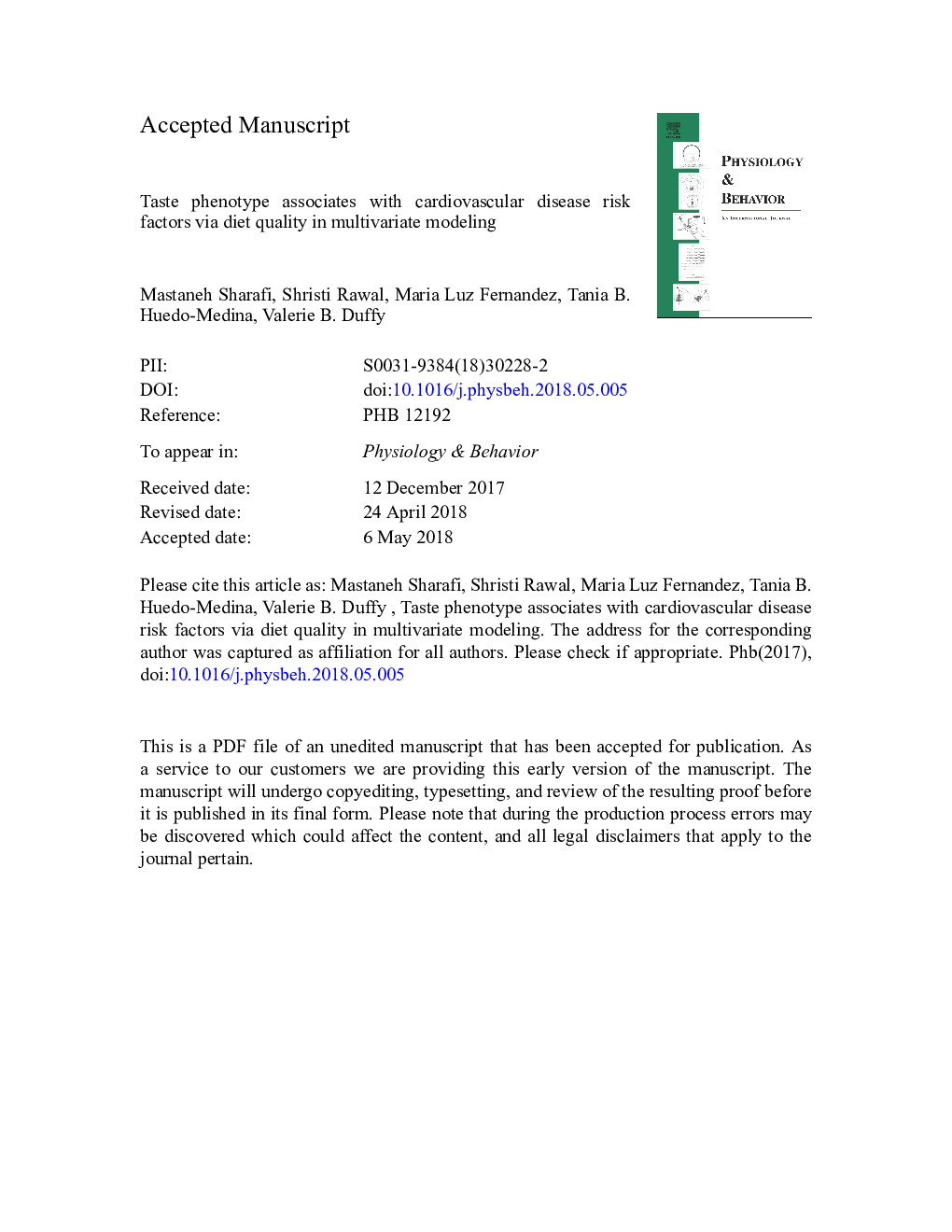| کد مقاله | کد نشریه | سال انتشار | مقاله انگلیسی | نسخه تمام متن |
|---|---|---|---|---|
| 8650241 | 1571124 | 2018 | 40 صفحه PDF | دانلود رایگان |
عنوان انگلیسی مقاله ISI
Taste phenotype associates with cardiovascular disease risk factors via diet quality in multivariate modeling
ترجمه فارسی عنوان
طعم فنوتیپ همبستگی با عوامل خطر بیماریهای قلبی و عروقی از طریق کیفیت رژیم در مدل سازی چند متغیره
دانلود مقاله + سفارش ترجمه
دانلود مقاله ISI انگلیسی
رایگان برای ایرانیان
کلمات کلیدی
کیفیت غذا، چاقی مرکزی، ترجیح غذا، مصرف غذا، طعم عوامل خطر بیماری قلبی عروقی،
موضوعات مرتبط
علوم زیستی و بیوفناوری
بیوشیمی، ژنتیک و زیست شناسی مولکولی
فیزیولوژی
چکیده انگلیسی
Sensations from foods and beverages drive dietary choices, which in turn, affect risk of diet-related diseases. Perception of these sensation varies with environmental and genetic influences. This observational study aimed to examine associations between chemosensory phenotype, diet and cardiovascular disease (CVD) risk. Reportedly healthy women (nâ¯=â¯110, average age 45â¯Â±â¯9â¯years) participated in laboratory-based measures of chemosensory phenotype (taste and smell function, propylthiouracil (PROP) bitterness) and CVD risk factors (waist circumference, blood pressure, serum lipids). Diet variables included preference and intake of sweet/high-fat foods, dietary restraint, and diet quality based on reported preference (Healthy Eating Preference Index-HEPI) and intake (Healthy Eating Index-HEI). We found that females who reported high preference yet low consumption of sweet/high-fat foods had the highest dietary restraint and depressed quinine taste function. PROP nontasters were more likely to report lower diet quality; PROP supertasters more likely to consume but not like a healthy diet. Multivariate structural models were fitted to identify predictors of CVD risk factors. Reliable latent taste (quinine taste function, PROP tasting) and smell (odor intensity) variables were identified, with taste explaining more variance in the CVD risk factors. Lower bitter taste perception was associated with elevated risk. In multivariate models, the HEPI completely mediated the taste-adiposity and taste-HDL associations and partially mediated the taste-triglyceride or taste-systolic blood pressure associations. The taste-LDL pathway was significant and direct. The HEI could not replace HEPI in adequate models. However, using a latent diet quality variable with HEPI and HEI, increased the strength of association between diet quality and adiposity or CVD risk factors. In conclusion, bitter taste phenotype was associated with CVD risk factors via diet quality, particularly when assessed by level of food liking/disliking.
ناشر
Database: Elsevier - ScienceDirect (ساینس دایرکت)
Journal: Physiology & Behavior - Volume 194, 1 October 2018, Pages 103-112
Journal: Physiology & Behavior - Volume 194, 1 October 2018, Pages 103-112
نویسندگان
Mastaneh Sharafi, Shristi Rawal, Maria Luz Fernandez, Tania B. Huedo-Medina, Valerie B. Duffy,
